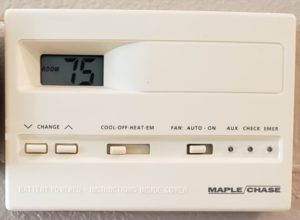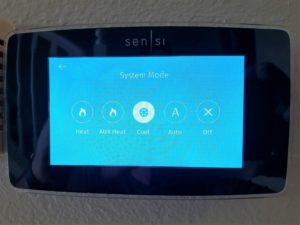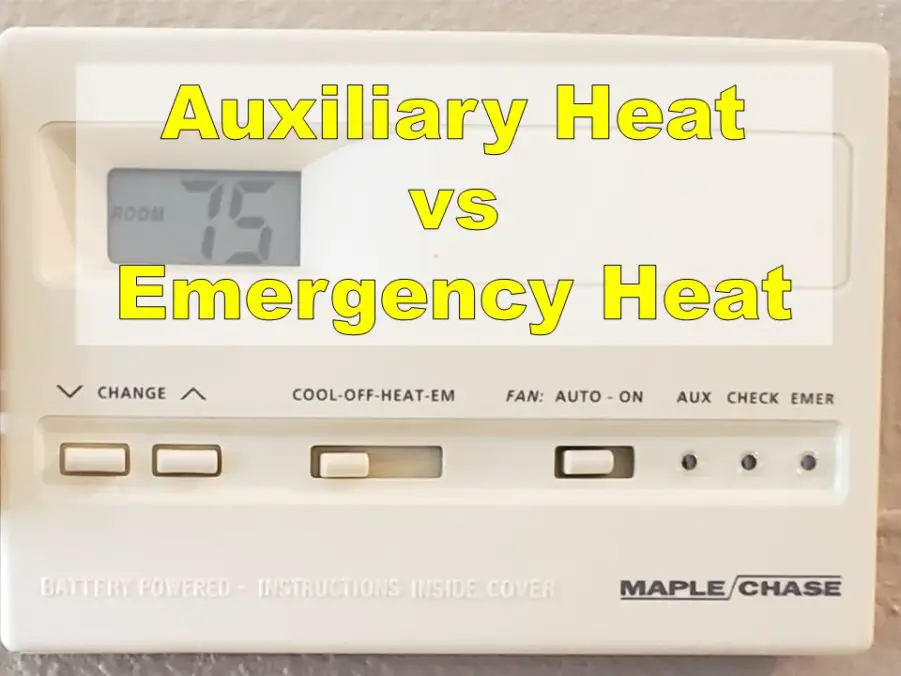Auxiliary Heat vs Emergency Heat What’s the Difference
If your home is heated by a heat pump you have probably seen a button or switch on your thermostat labeled with one of these terms:
- Emergency Heat
- EM Heat
- Auxiliary Heat
- Aux Heat
Do you know what that switch does and when to use it? If you don’t, you’re not the only one. In fact, many home owners don’t understand the difference between these terms and when they should be used.
Do I have Emergency or Auxiliary Heat?
The first step to understanding the difference is determining type of heating system you have. There are 4 common types of home heating systems.
- Furnace – Fuel is burnt to create heat that is blown through ducts.
- Boilers – water is heated and that water is pumped to radiators to distribute the heat.
- Electric Radiant – Baseboard or free standing electric heaters located where the heat is needed.
- Heat Pumps – Work like an air conditioner in reverse, air is blown over heated coils and then through ducts.
Of these 4 systems, heat pumps are the only ones that typically have EM or Aux heat. That is because heat pumps may not be able to meet the heating demand under some conditions.
How does a heat pump work?
Heat pumps are a very efficient form of heat, this is because they do not use the electricity to create the heat, they only move it. There are 2 types of heat pumps, air and ground source or geothermal. They both use the same principle to heat your home. Heat is drawn from the outside air or ground and moved into your home to heat it. This article on how stuff works goes into more detail on the process. If you have a geothermal heat pump you may not have auxiliary heat. This is because even during the winter months when the outside air might not supply enough heat to warm your house the ground is still at a more constant temperature.
Why is auxiliary or emergency heat needed?
When the air temperature gets too low your need a secondary source to help a heat pump warm your home. This is usually done with a heat strip that is installed in the air handler of your HVAC system. The heat strip functions like an electric space heater. It creates heat by passing a high electrical current through a resistive wire.
The same heat strip is used for both auxiliary and emergency heat.
So, at what temperature does a heat pump become ineffective?
This depends on a variety of factors, but in general at temperatures below 40 degrees F heat pumps will have trouble maintaining a comfortable temperature in your home.
Auxiliary Heat Explained
When should you use auxiliary heat?
Auxiliary heat should be used any time your heat pump cannot reach the desired temperature on it’s own.
How do you turn on auxiliary heat?
With older thermostats auxiliary heat is turned on one of 2 ways.
- Either by a switch or button labeled auxiliary or aux heat. After you turn the aux heat on the heat strip will run any time there is a call for heat.
- The heat strip is automatically used when the outside temperature is below a predetermined point.

auxiliary emergency heat thermostat
Auxiliary Heat will cost you more money to run!
A much better way to control your auxiliary heat is to update to a smart thermostat. Smart thermostats will automatically decide when the heat strip is needed and only use it during those times. This has 3 benefits to you.
- You will save money by only running the heat strip when it is necessary.
- You don’t have to remember to turn the auxiliary heat mode on and off.
- They can integrate with other smart home systems like Amazon’s Alexa.

Sensi Touch Wi-Fi thermostat
If you are interested in updating your thermostat check out this article. I just went through the process myself.
Emergency Heat Explained
How does emergency heat work on a heat pump?
Emergency heat works by turning the heat pump off completely and only the heat strip is used.
Emergency Heat is the most expensive way to heat your home!
When should you switch from heat pump to emergency heat?
Emergency heat should not be used under normal circumstances. The only time you should have to enable it is when the heat pump is broken and needs to be serviced. Now you know what that emergency heat setting on your thermostat is for.
Wrap Up
Hopefully now you understand a little more about how your heating system works and what the difference between auxiliary heat and emergency heat is. Just remember that emergency heat is for emergencies. So, don’t turn it on unless something is wrong with your heat pump.
If you found this article useful please do me a favor. I’m always looking for ways to help so leave a comment below with a question you would like answered related to smart homes or technology.
Thanks,
Jason


11 Comments on “Auxiliary Heat vs Emergency Heat (What’s the Difference)”
Great info, thanks for sharing!!
No Problem Don, I’m glad you found it helpful.
Thanks,
Jason
Thank for sharing, Bro! Great helpful knowledge!
James, Thanks for the compliment.
Jason
Jason, I will try to be brief. A few years back I was told (incorrectly) to run my Goodman heat pump in the emergency heat mode in very cold weather…..generally below 20 degrees. So, I did that and continued until I was properly educated. That education happened last winter here as it was very cold in central Ohio. I had the outside unit and air handler checked this past spring (2018) and the tech made some changes to how the sequencers ( not sure on terminology ) were wired. Fast forward to today, (Jan 20th, 2019) I decided to test the heat pump in emergency heat mode. The outside unit is off, the air handler runs, but duct temp is very cool. Turn back to regular auto heat mode, air at duct much warmer, and when in this mode (so far ) temp inside the house is maintained. But, I’d certainly like to know that the emergency heat will work if ever needed? I suspect the tech may have done something? Any other possibilities? Does the thermostat need to register a failure in the outside unit before allowing emergency heat? Thank you much, Brian N
It does sound like the wiring may have been messed up causing the resistance heat coils to run all the time. This would work, but will be more expensive because they aren’t very efficient.
Thanks, Jason
My heat pump will now kick into auxiliary heat instead of emergency heat if the temperature is 1 degree off. Which is more expensive to use between the two.?
Darlene, emergency heat will usually be more expensive because only the resistant heat coils are used and they are less efficient.
Thanks, Jason
Great info! Best explanation I have found!
Our thermostat had E-heat on last winter for the 1st time in 13 years, and our electric bill increased drastically because of it! Then our air conditioning didnt work. Had to have unit charged and We finally found a blockage to our Geothermal line!
Now we know when/if E-heat comes on again, to get it checked immediately! This year it is working great so far and have already had several nights/days below freezing and it’s only November!
Thank you for the explanation!
I’m glad I could provide you with a good explanation. Sorry to hear about your bill last year, hopefully that doesn’t happen again 🙂
Jason
Thanks had a new thermostat put in last year never told about heat aux or emer used emer last year for heat bill was very high look up on site after reading your article will us aux this year.Live in Texas one day it’s in the 90 degree next day 40 degrees that Texas.Thanks hope I’m readind this right.